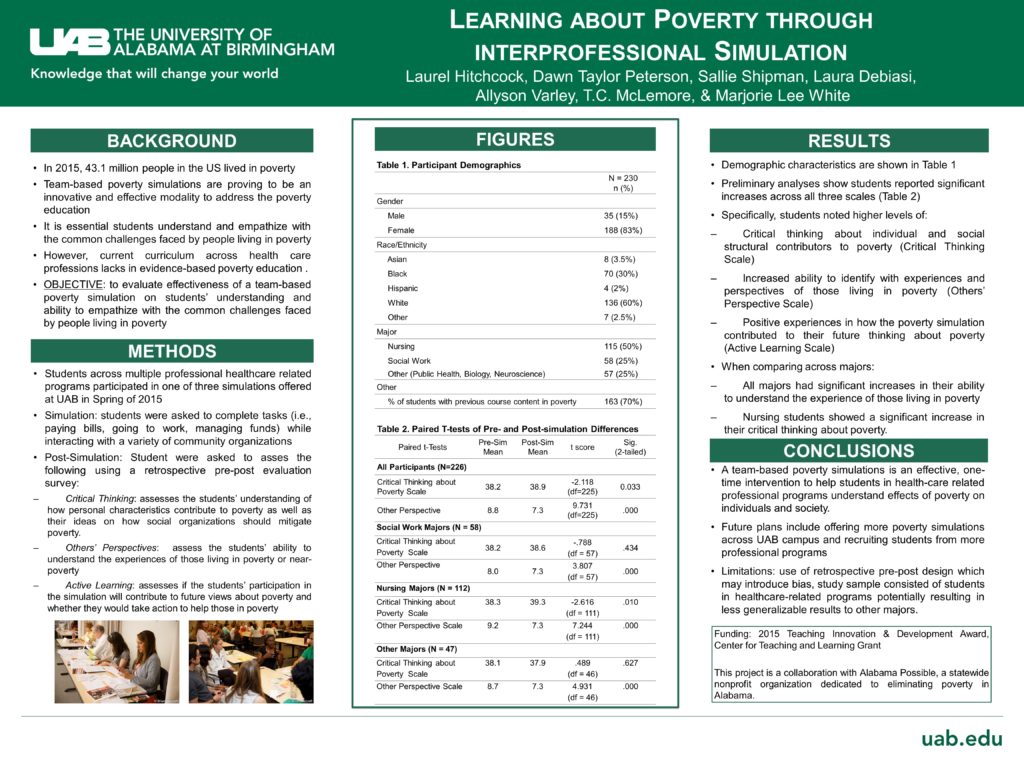#ESCUNO2016 Annual Conference – 10/11/16
This week, I’m attending the 2016 annual conference for the Engaged Scholarship Consortium in Omaha, Nebraska. Yes, returning to the Midwest for a few days! Over the next two days, I’ll be presenting with three colleagues from the University of Alabama at Birmingham, Drs. Erika Rinker, Laura Debiasi and Sallie Shipman.
Today, I will be presenting a poster with Laura and Sallie about our work with poverty simulations at #UAB. If you are at the conference, please join us at the Poster Session in the CenturyLink Ballroom C at 3:30 PM. Our work focuses on why and how we started implementing poverty simulations with students from diverse majors and professional programs across our campus. Poverty simulations are increasingly common in higher education, offering an innovative modality to increase students’ understanding of poverty. The simulation enables participants to view poverty from different angles in an experiential setting. The poster will cover implementation of poverty simulations and present preliminary findings on the learning outcomes for students. Other member of our working group were not able to join us at the Conference, Allyson Varley and Drs. Dawn Talyor Peterson and Marjorie Lee White.
Here is our abstract:
According to the US Census Bureau, approximately 46.7 million people, or 14.8% of the US population, lived in poverty in 2014. Social work, nursing, and other health and human service students provide services to people living in poverty, both in school and in the workforce. Therefore, it is essential that students understand and empathize with the common challenges faced by people living in poverty.
The poverty simulation enables participants to view poverty from different angles in an experiential, team-based setting. The most common simulation is the Community Action Poverty Simulation (CAPS), created by the Missouri Association for Community Action (MACA). During a simulation, participants are placed into teams of families where they seek to provide food, shelter and other basic necessities during the simulation while interacting with various community resources staffed by low-income volunteers. The literature shows that the CAPS poverty simulations are a well-received valid learning tool for increasing awareness and understanding of the complexities of poverty. Students who complete a poverty simulation report increased sensitivity to and awareness of the problems for people living in poverty and state that they are more likely to engage in social action to address poverty in their communities.
 Participants who attend this presentation will: 1) learn the basic mechanics of a poverty simulation and how it is an effect tool of engaged learning for economic justice; 2) determine how educators can duplicate the planning process for a poverty simulation at their own institutions; and 3) appreciate the role of professional collaboration in the planning and development of service-learning projects across a curriculum. The presenters will share their experiences in executing the simulation, and assessing students learning outcomes with reflection essays and pre-post surveys. Lessons learned from the project will be shared and implications for poverty education will be reviewed.
Participants who attend this presentation will: 1) learn the basic mechanics of a poverty simulation and how it is an effect tool of engaged learning for economic justice; 2) determine how educators can duplicate the planning process for a poverty simulation at their own institutions; and 3) appreciate the role of professional collaboration in the planning and development of service-learning projects across a curriculum. The presenters will share their experiences in executing the simulation, and assessing students learning outcomes with reflection essays and pre-post surveys. Lessons learned from the project will be shared and implications for poverty education will be reviewed.
How to cite this post:


